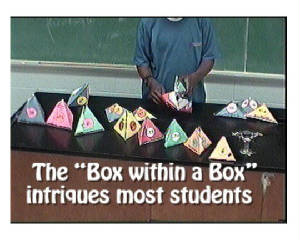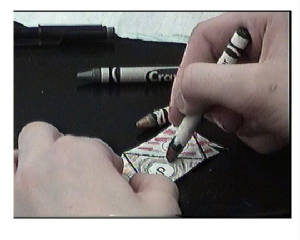|
Below a student unfolds each of the eight cubes, one at a time, as he presents before the class his finished model.
He explains the concepts relating to each face on the modules. This alternative assessment opportunity for the teacher
has the added benefit of repeating the lesson again and again to the whole class as one student follows the next in exhibiting
his finished Cubic Period Chart of the Elements while demonstrating his/her own knowledge of the concepts represented
on the 3-D graphic organizer.

The Box-inside-a-Box presentation intrigues students as well as Chemistry teachers who will this Project
Oriented instructional method very acceptable to the students who will work diligently day after day to finish their
own take home "Show and Tell." This approach allows for Alternative Grading and offers
the more manually gifted students the opportunity to contribute and receive approval and high grades for laboratory credits.
The students are very open to what is actually as subtle Interactive Lecturing opportunity as the teacher
plays the role of a project Facilitators, assisting the students in the construction detail, but actually
using the opportunity to explain the concepts found on each of the eight model cubes.

During the construction activity the students use colored felt tips, crayons, colored pencils, or even water color paints
to emphasize the sets and groups of concepts related to a particular subject on the individual cube which pertains to a whole
topic in the text book.
|

